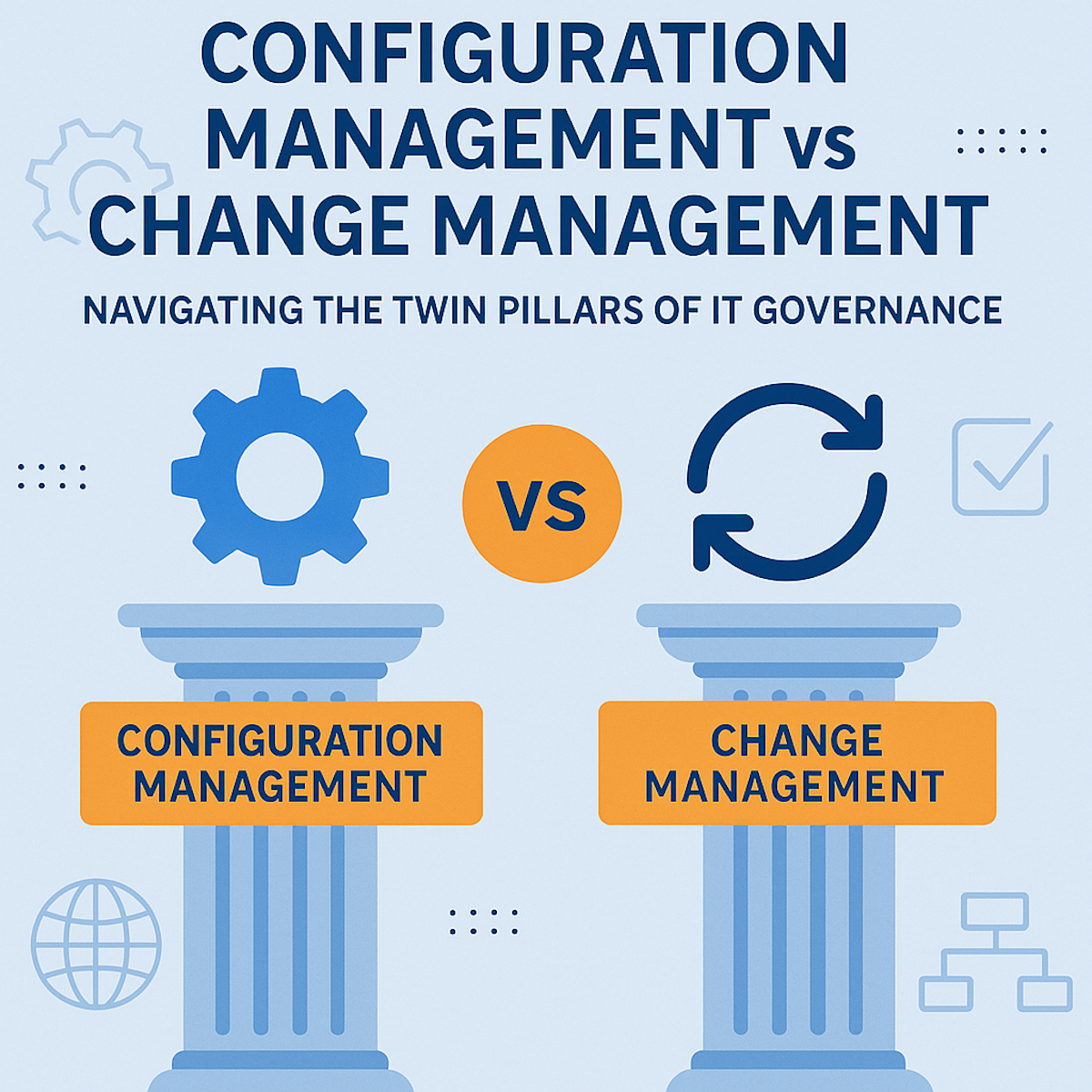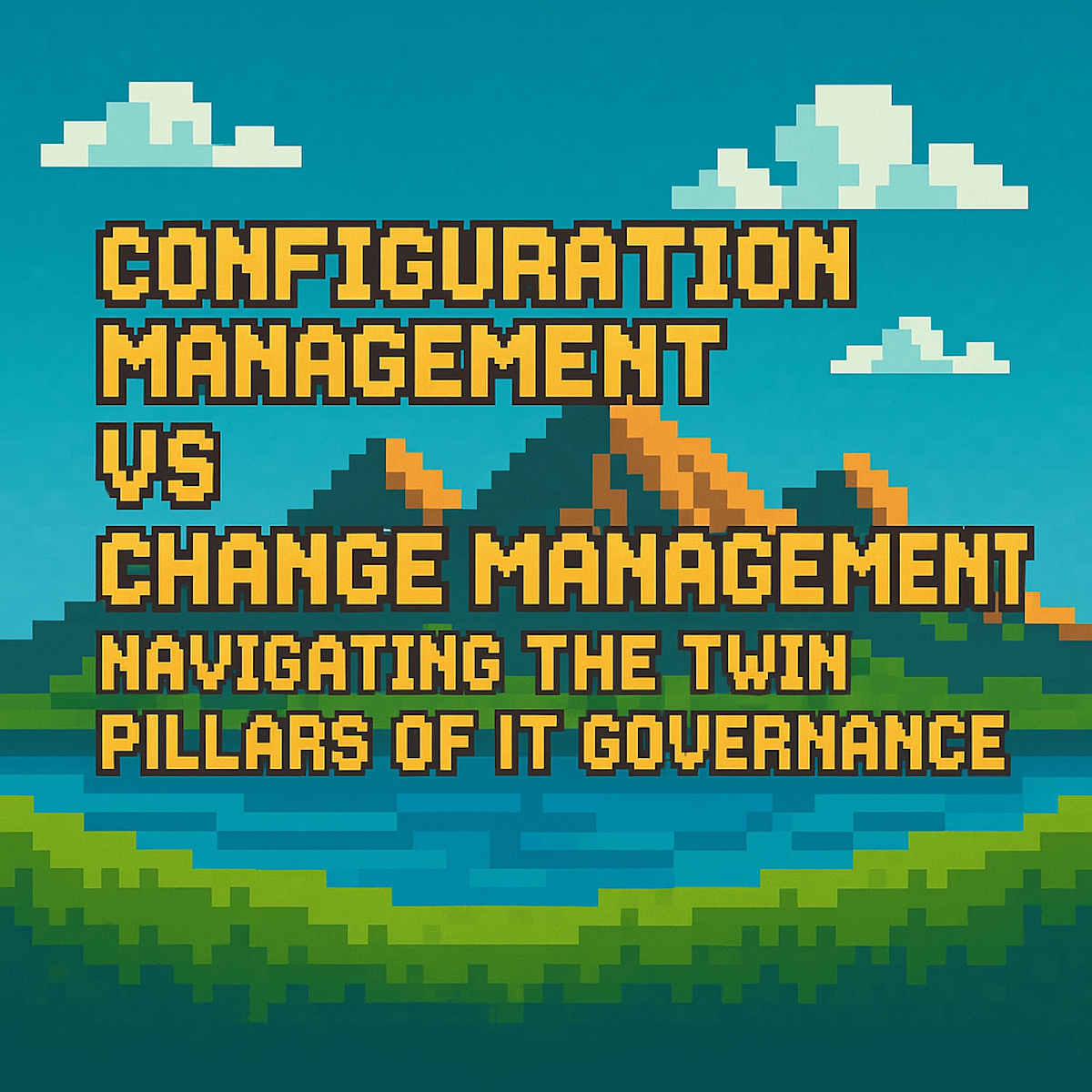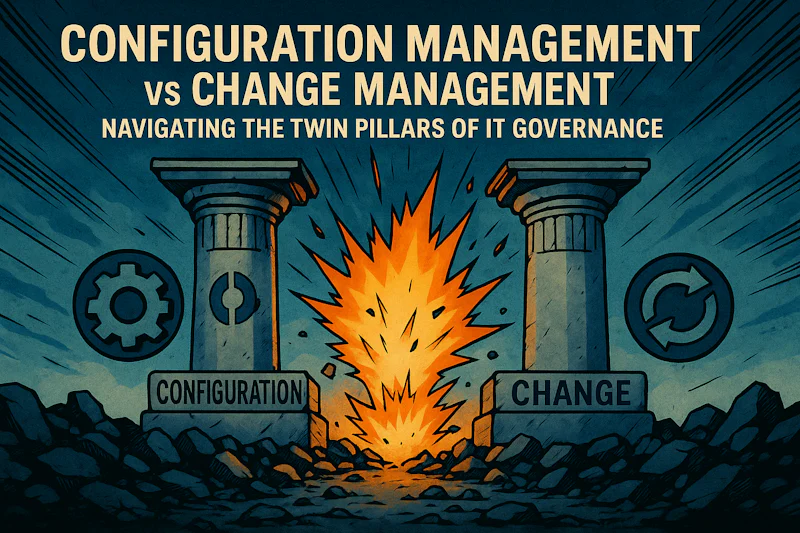Modern digital businesses depend on resilient, responsive and well‑governed IT systems. As organizations adopt DevOps, agile development and cloud infrastructure, they are challenged to balance rapid innovation with stability and compliance. Two practices lie at the heart of this balancing act: configuration management and change management. While they are often mentioned together, these disciplines address different facets of IT governance. Configuration management focuses on establishing and maintaining a consistent state of technology assets, whereas change management governs the process of introducing alterations. Confusing the two can lead to operational inefficiencies, security risks or compliance failures. This comprehensive guide demystifies the differences between configuration management and change management, explores how frameworks like ITIL and DevOps define them, and offers actionable guidance for IT leaders.
Understanding Configuration Management
Definition and Purpose
Configuration management is a discipline that ensures all aspects of an IT system – servers, applications, network devices, cloud services and documentation – are identified, recorded and maintained in a consistent state. It creates a baseline of configuration items (CIs) and monitors any deviations. According to the ITIL framework, the configuration management process includes a configuration model, a list of CIs, and a configuration management system or configuration management database (CMDB) that records and verifies items and their relationships techtarget.com. The goal is to deliver visibility into what assets exist, how they are configured and how they depend on each other.
Key Components
Configuration management comprises several interrelated activities:
Identification: The first step is to define and tag configuration items—systems, hardware components, software versions, documentation and relationships. This ensures every asset is uniquely identifiable cloudaware.com.
Baseline Definition: Organizations establish a baseline – a desired state of each CI. Baselines help detect drift and serve as reference points when troubleshooting or auditing medium.com.
Control: The discipline ensures that any proposed changes to configurations go through defined checks and approvals. Configuration control is part of both configuration and change management medium.com.
Status Accounting: Continuous monitoring compares current states against baselines to detect unauthorized changes and configuration drift cloudaware.com.
Verification and Audit: Regular audits verify that recorded information matches reality and that the correct baselines are maintained medium.com.
Responsibilities: Roles and responsibilities must be clearly assigned—administrators, engineers and auditors ensure the process runs smoothly medium.com.
Benefits of Configuration Management

Implementing configuration management delivers several tangible benefits:
Consistent environments: By maintaining accurate records and baselines, teams ensure that development, testing and production environments remain synchronized. This consistency reduces deployment issues and configuration drift.
Scalability: A disciplined approach allows organizations to scale systems without scaling staff. Central repositories and automation ensure that as infrastructure grows, configuration data remains manageable medium.com.
Efficiency & Cost Savings: Automated configuration tracking reduces manual work, prevents errors and saves costs by avoiding downtime and lengthy investigations medium.com.
Security & Compliance: Visibility into assets and their configurations reduces the risk of unauthorized changes and simplifies compliance audits. Organizations can quickly demonstrate adherence to policies cloudaware.com.
Configuration Management Tools
Numerous tools help automate and enforce configuration management. Popular choices include Ansible, Puppet, CFEngine, Chef and Salt. When selecting a tool, IT leaders should evaluate robustness, flexibility, the quality of the feedback loop, complexity and cost medium.com. For example, Ansible provides agentless automation with an easy learning curve, whereas Puppet and Chef offer more mature ecosystems for large enterprises. Regardless of the tool, integration with version control systems and CI/CD pipelines is critical for traceability and reproducibility.
Understanding Change Management
Definition and Purpose
Change management governs how modifications are introduced into IT environments to minimize risk and disruption. ITIL defines change management as a set of standardized methods and procedures used to handle changes, enabling organizations to track and identify changes, ensure that only authorized modifications are made and minimize the impact of change-related incidents techtarget.com. It strives to answer the questions: What needs to change? Why? How will it be implemented? What risks does it pose? Who needs to approve it?
Process and Stakeholders
A typical change management process comprises several stages:
Initiation: A change request (often called a Request for Change or RFC) is submitted, describing the desired modification and its business justification cloudaware.com.
Impact Analysis: The change team assesses potential impacts on existing CIs, services and stakeholders. Configuration data is crucial here because it reveals dependencies and helps gauge risks projectmanagertemplate.com.
Approval Workflows: Approvals may involve a Change Advisory Board (CAB) or automated workflows. Major changes require cross‑team collaboration and careful planning virima.com. Minor changes might follow a streamlined path.
Implementation Planning: Approved changes are scheduled. Clear instructions and rollback plans minimize downtime and facilitate recovery cloudaware.com.
Execution: Technical teams implement the change while adhering to defined policies and communication protocols.
Review and Closure: After implementation, the change’s success is reviewed. Lessons learned inform future changes, and the CMDB is updated accordingly cloudaware.com.
Stakeholders include IT managers, system owners, developers, operations teams and end‑users. Communication is vital: Virima notes that change management involves people and ensures stakeholders are comfortable with and can effectively use the changes virima.com.

Types of Changes
Change management classifies modifications according to their complexity and risk:
Standard Changes: Pre‑approved, low‑risk changes like routine patches or user access requests. These follow a predefined process and require minimal approval.
Minor Changes: Small changes that require some coordination but minimal planning. According to Virima, they may be executed quickly with less involvement from the CAB virima.com.
Major Changes: High‑risk or high‑impact changes such as system upgrades or service migrations. These require extensive planning, cross‑team collaboration and formal approvals virima.com.
Emergency Changes: Unplanned changes needed to fix critical issues (e.g., zero-day vulnerabilities). Emergency procedures expedite approvals but still aim for documentation and minimal risk.
Benefits of Change Management
Properly implemented change management offers several benefits:
Risk Mitigation: By requiring impact analysis and approval, the process reduces outages and service disruptions techtarget.com.
Predictability: Planning and scheduling ensure changes occur in a controlled manner, improving service reliability.
Compliance and Auditability: Documentation of requests, approvals and outcomes provides an audit trail, aiding regulatory compliance cloudaware.com.
Stakeholder Confidence: Transparent processes and communication increase trust across IT and business units virima.com.
Configuration Management vs Change Management: Key Differences and Overlaps
Although both practices contribute to IT stability, configuration management and change management focus on distinct objectives. Summarizing several sources:
Primary Purpose: Configuration management aims to maintain accurate records of the current state of infrastructure and establish baselines projectmanagertemplate.com. Change management focuses on controlling modifications to those systems to minimize risk projectmanagertemplate.com.
Focus and Scope: Configuration management is asset‑oriented, encompassing physical and virtual resources (servers, networks, documentation, software) projectmanagertemplate.com. Change management is process‑oriented and applies to planned changes across hardware, software and processes projectmanagertemplate.com.
Timing: Configuration management deals with “what is” – the current state. Change management addresses “what will be” – the modifications planned or underway freshworks.com. Configuration management monitors drift and state consistency, while change management oversees the introduction of new states.
Outcome: Effective configuration management results in a structured IT environment with up‑to‑date records. Successful change management results in smooth implementation of authorized changes with minimal disruption projectmanagertemplate.com.
Activities: Configuration management activities include identifying, recording and verifying CIs; change management activities include assessing, approving and implementing changes projectmanagertemplate.com.
Dependency: Change management relies on configuration data to assess impact and coordinate changes; configuration management depends on change management to ensure modifications are properly controlledp rojectmanagertemplate.com.
Overlap and Interaction
The two disciplines are complementary and must interoperate. Without configuration management, change management cannot assess impacts or maintain records; without change management, configuration items risk being altered indiscriminately. Overlap often occurs during the change implementation stage: when a team updates a system, configuration management records those changes in the CMDB, while change management ensures proper approvals and communication techtarget.com. For example, migrating a database requires updating the CMDB (configuration management) and following change processes with analysis, notifications and approvals techtarget.com.
Frameworks and Methodologies
ITIL (Information Technology Infrastructure Library)
ITIL remains the de facto framework for IT service management. It defines change management as a process within Service Transition, with the aim of standardizing methods to handle changes, reducing incidents and maintaining service quality techtarget.com. ITIL 4 emphasises flexibility and integrates with agile and DevOps practices, positioning change management as part of a Service Value System that continually delivers value alloysoftware.com.
ITIL also outlines configuration management under Service Transition. The configuration management system (CMS) or CMDB tracks CIs, relationships and baselines techtarget.com. The CMDB becomes a critical input to change management; impact analysis and risk assessments rely on accurate configuration data. ITIL encourages regular verification audits and status accounting to ensure the integrity of this data.
DevOps and Infrastructure as Code
DevOps aims to bridge development and operations through automation, collaboration and continuous delivery. Configuration management in DevOps uses infrastructure as code (IaC) and configuration as code to define desired states using version‑controlled scripts. These scripts are executed by tools such as Ansible, Puppet and Terraform, enabling reproducible environments and rapid provisioning medium.com. Configuration management ensures consistency across the software lifecycle and helps teams avoid configuration drift medium.com.
Change management in DevOps must adapt to continuous integration/continuous delivery (CI/CD) pipelines. Automated tests, feature flags and canary releases reduce risk and accelerate deployment, but they still require change governance. Modern change management frameworks integrate approvals into code repositories (e.g., pull‑request reviews) or rely on continuous compliance where policies are codified and enforced automatically. ITIL’s Change Advisory Board may become more virtualized or decentralized in DevOps contexts. The focus shifts from heavy approvals to high‑trust, low‑friction workflows, while still maintaining audit trails.
Agile Change Control
Agile methodologies emphasise iterative development and frequent delivery. Change is expected and welcomed. Agile teams often incorporate change management into their sprint planning and daily workflows rather than treating it as a separate gating process. However, even in agile, major changes still require risk assessment and stakeholder communication. Integrating configuration management into agile ensures that teams always develop against a known baseline and can quickly revert if a change fails. Agile frameworks complement ITIL by emphasizing adaptability, continuous feedback and incremental improvements alloysoftware.com.
Practical Implementation Guidance
Implementing configuration and change management requires more than selecting tools. It demands organizational alignment, well‑defined processes and cultural commitment.
Steps to Implement Configuration Management
Define Scope and Objectives: Determine which assets and environments will be tracked. Start with critical services and expand over time.
Establish Baselines: For each CI, define its desired state (e.g., operating system version, configuration files, dependencies). Use automation tools to enforce these baselines.
Create a CMDB: Populate a central repository with CIs and their relationships. Tools with automated discovery can help avoid “ghost assets” and ensure completeness cloudaware.com.
Implement Automated Monitoring: Continuously detect drift between actual and desired states and trigger alerts when unauthorized changes occur.
Integrate with Version Control: Store configuration code and infrastructure definitions in version control systems to enable rollbacks and auditing.
Assign Roles and Responsibilities: Define who is responsible for maintaining baselines, approving configuration changes, and auditing compliance. Provide training to foster accountability medium.com.
Continual Improvement: Periodically review configuration management processes, update baselines and refine tools. Collect feedback from engineers and auditors.
Steps to Implement Change Management
Develop a Change Policy: Document the goals, scope and types of changes (standard, minor, major, emergency). Clarify criteria and risk levels.
Establish Change Roles: Identify stakeholders, including change managers, approvers, testers and communication leads. Provide training on procedures and expectations virima.com.
Implement a Request System: Use a service management platform (e.g., ServiceNow, Jira Service Management) to log RFCs. Capture metadata (priority, business justification, affected assets) cloudaware.com.
Standardize Impact Analysis: Use CMDB data to evaluate dependencies and potential disruptions. Build templates for common change types, enabling consistent risk assessments projectmanagertemplate.com.
Define Approval Workflows: For each change type, specify approval authorities. Automate notifications and escalations. Consider a CAB for major changes virima.com.
Plan Implementation Windows: Schedule changes during maintenance windows or low‑traffic periods. Document tasks, rollback steps and communication plans.
Perform Changes: Follow documented procedures; communicate status updates to stakeholders. Use change kits or automation scripts for consistency.
Review and Close: Assess outcomes. Did the change deliver the desired result? Were there incidents? Record lessons learned and update the CMDB.
Integrating Configuration and Change Management
For optimal results, organizations must integrate both practices:
Use Configuration Data in Impact Analysis: Change managers should consult the CMDB to identify dependencies and potential risks for each change techtarget.com.
Update the CMDB After Changes: After implementing a change, update the configuration management system to reflect the new state. This ensures accuracy and enables future impact analysis.
Shared Automation: Use configuration management tools to apply approved changes programmatically. This reduces errors and ensures consistency across environments.
Continuous Auditing: Regularly compare actual configurations against baselines and change records. Investigate discrepancies to detect unauthorized changes or process gaps.
Feedback Loop: Encourage cross‑functional teams to communicate about configuration drift, failed changes and lessons learned. Adapt processes accordingly to reduce friction.
Real‑World Scenarios and Examples
Scenario 1: Patching a Critical Vulnerability
A security team discovers a critical vulnerability in the operating system used across a fleet of web servers. They need to apply a patch quickly but with minimal disruption.
Configuration View: Configuration management data reveals exactly which servers are running the affected OS version and which applications depend on them. The baseline indicates the desired patch level.
Change Process: A change request is submitted, classifying it as an emergency change due to security risk. Impact analysis, using the CMDB, identifies dependencies and helps plan the patch roll‑out sequence. Approvals are expedited, but documentation is still produced for audit purposes virima.com.
Implementation: Automation scripts (Ansible) apply the patch across servers during a scheduled window. Configuration management monitors the updated state, while change management ensures communication and fallback plans.
Post‑Change: The CMDB is updated with the new version information. A review notes the success and logs lessons learned for future emergency changes.
Scenario 2: Migrating to Cloud Infrastructure
A company decides to migrate its on‑premises database servers to a cloud service. This major change impacts applications, networks and security policies.
Configuration Analysis: The CMDB lists all applications that connect to the database and network dependencies. Baselines document current performance metrics.
Change Management Planning: A major change request is submitted. The change advisory board reviews risk, cost and benefits. Impact analysis leverages configuration data to identify all touchpoints, informing the migration plan techtarget.com.
Execution: The team performs the migration in phases, aligning with planned maintenance windows. Configuration management scripts deploy infrastructure as code templates to recreate servers and networks in the cloud.
Monitoring: After migration, configuration management verifies that cloud instances match the approved baseline. Change management reviews performance metrics and user feedback to ensure the change achieved its goals.
Benefits Realization: Accurate configuration records and structured change processes reduce downtime, ensure compliance with data residency regulations and support quick rollback if necessary.
Scenario 3: Continuous Delivery in a DevOps Pipeline
A software company uses a CI/CD pipeline to deploy updates to its SaaS platform multiple times per day. How do configuration and change management coexist in this high‑velocity environment?
Configuration as Code: The entire infrastructure (servers, databases, networking) is defined in code and stored in a version‑controlled repository. Configuration management tools automatically provision and maintain environments. This ensures consistency and allows rapid recovery.
Automated Change Approvals: Minor changes (e.g., feature toggles, routine deployments) are pre‑approved via automated policies. Pull‑request reviews and automated tests serve as change checkpoints, aligning with the DevOps principle of fast feedback.
Service Catalog and Standard Changes: Frequent deployments to production may be categorized as standard changes, enabling streamlined approvals. Major changes, such as database schema migrations, still require additional scrutiny and sign‑offs.
Monitoring and Observability: Real‑time monitoring detects anomalies after deployments. If a change introduces errors, automated rollbacks revert the configuration to the previous baseline. Logging systems record changes for post‑mortem analysis.
Cultural Alignment: Development, operations and security teams collaborate on configuration and change processes. Continuous improvement ensures that policies remain effective while enabling agility alloysoftware.com.
Lessons Learned from Real‑World Practices
These scenarios highlight the synergy between configuration management and change management. Key takeaways include:
Visibility enables control: A robust CMDB and configuration management system provide the data necessary for impact analysis, risk assessment and compliance audits cloudaware.com.
Automation is essential: Manual processes cannot scale with modern DevOps practices. Automating both configuration enforcement and change workflows reduces human error and accelerates delivery.
Risk varies by change type: Not all changes are equal. Classifying changes allows organizations to tailor governance accordingly—minor changes may use simplified workflows, while major changes involve more stakeholders virima.com.
Communication fosters trust: Transparent change management processes and up‑to‑date configuration data improve cross‑team understanding and stakeholder confidence virima.com.
Continuous improvement: Both disciplines require periodic review and adaptation. Feedback from audits, post‑change reviews and incident post‑mortems helps refine baselines, policies and automation scripts.
Conclusion: Selecting the Right Approach for Your Organization
Configuration management and change management are twin pillars of modern IT governance. Configuration management provides visibility, consistency and a trusted baseline for all technology assets projectmanagertemplate.com. Change management ensures that modifications to those assets occur in a controlled, predictable manner, reducing risk and maintaining service quality techtarget.com. The two practices overlap: configuration data informs change decisions, and change management updates configuration records. When integrated effectively, they enable organizations to innovate rapidly while remaining compliant and resilient.
Which practice should you prioritize? The answer depends on your organization’s maturity and goals. For companies adopting cloud infrastructure or DevOps, configuration management through infrastructure as code is a foundational step—without it, change processes lack accurate data. For highly regulated industries or enterprises facing frequent outages, formal change management may take precedence to instill discipline and accountability. Ultimately, the most effective strategy is to implement both practices in tandem, aligning them with frameworks such as ITIL, agile and DevOps. By investing in automation, fostering cross‑functional collaboration and continually refining processes, IT leaders can achieve a balance between velocity and stability—delivering reliable services that delight customers and meet business objectives.
In summary, the report emphasizes that configuration management ensures accurate, baseline-aligned records of all IT assets, while change management focuses on governing modifications to minimize risk projectmanagertemplate.comtechtarget.com. It highlights how configuration management tracks the “what is” and change management handles the “what will be,” making them complementary disciplines freshworks.com.
The report also underscores that integration between these practices is vital: configuration data feeds change impact analysis and change records update the configuration baseline techtarget.com. Practical guidelines demonstrate how organizations can implement both practices through automation, clear roles, and iterative improvement, while frameworks like ITIL, DevOps, and Agile provide structured approaches to balance stability and agility.
Feel free to review the Markdown file for full details, real-world scenarios, and a comprehensive comparison table.
If you have any questions or need further changes, just let me know!


